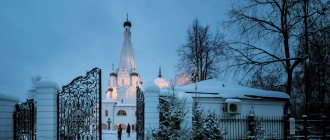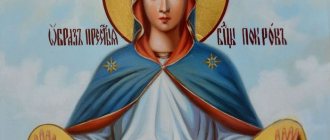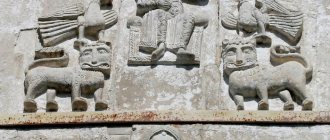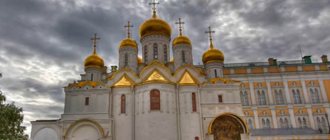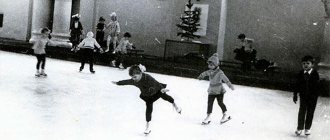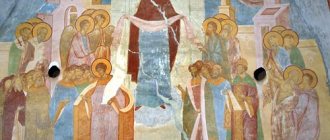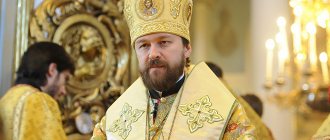The Church of the Intercession in Fili was erected in the early 1690s on the territory of the country estate of boyar L.K. Naryshkin. The temple consists of two parts. The first of them - the Church of the Intercession - is considered the lower one, and the second - the Savior Not Made by Hands - is called the upper one. This beautiful temple was recognized as a masterpiece of the unique Naryshkin style. This architectural monument dates back to early Peter the Great. The Church of the Savior Not Made by Hands looks the same as it did when built. Its unique interiors with icons of Kirill Ulanov and Karp Zolotarev were miraculously preserved and have survived to this day.
Wooden church
The very first church with the chapel of the Conception of St. Anne, built in Fili, was wooden. Documents have been preserved that say that the church was built in 1619. At that time, these lands belonged to Prince Mstislavsky. It is interesting that the Church of the Intercession in Fili appeared thanks to an important event associated with the Time of Troubles. In the fall of 1618, Hetman Sagaidachny, together with the Polish prince Vladislav, tried to storm the walls of Moscow. Russian troops managed to repel all enemy attacks. This great event marked the end of the turmoil and ruin of the Moscow state.
The defenders of the city saw in this some kind of special patronage of the Mother of God. And in honor of her they decided to build several temples. These are the Churches of the Intercession in Medvedkovo, Rubtsov, Fili and Izmailovo.
Construction of the estate
In 1689, the lands on which the village of Fili was located were transferred to the disposal of the boyar Naryshkin Lev Kirillovich. He was the uncle of Tsar Peter I. The new owner immediately began organizing his new possessions. At the very beginning, he built a solid house with a tower and a clock on it, then various outbuildings: a malt barn, stables and cattle yards. The estate had a large orchard and a beautiful park with terraces. In addition, there were also several cascading ponds, made using the latest technologies of that time.
Legend
But the most important construction that Naryshkin took up was the church in Fili. The legend says that its construction history is closely connected with the events that occurred during the Streletsky revolt in 1682. Then the archers killed Naryshkin’s older brothers, Afanasy and Ivan. The youngest, Lev Kirillovich, miraculously managed to escape. Then he swore that if he survived, he would definitely erect a temple in honor of the Most Holy Theotokos and in memory of his dead brothers.
7 years have passed since his rescue. Having received new lands, he did not forget about his promise. Naryshkin laid the foundation for a new stone Church of the Intercession of the Virgin.
How to get to the Church of the Intercession in Fili
The temple can be reached by car or any public transport. The Cathedral of the Intercession of the Blessed Virgin Mary is located at: Moscow, st. Novozavodskaya, 6.
It is best to get to the parish by metro - this way you will avoid traffic jams and not get lost. You need to get off at the Fili station and walk about five hundred meters from there.
The architectural monument that is the Church of the Intercession in Fili is not the only brainchild of its architect. The Temple of the Sign, which is located between Romanov Lane and Manezhnaya Square, also belongs to the authorship of the same unknown architect.
If you find an error, please select a piece of text and press Ctrl+Enter.
Stone Temple
As you know, there was already a Church of the Intercession on the territory of the estate, so in honor of this holy holiday the lower (winter) church was consecrated. It should be noted that the exact date of construction is unknown, since all the documents were burned in a fire in 1712. The Church of the Intercession in Fili, the style of which was ideal for a house church, had a presentable, solemn and elegant appearance. The luxury of the Naryshkin building was supposed to show the nobility, birth and wealth of its owner, as well as all the virtues that were inherent in him.
Temple Shrines and Celebrations
The main shrine of the church in Fili is an impressive carved iconostasis. In addition to many holy faces, you can see on it the original image of the Intercession of the Blessed Virgin Mary, as well as the icon of the Three Joys.
The original of the Savior Not Made by Hands was lost, but the cathedral contains a copy of it, which remains no less revered to this day.
The newly opened parish holds daily services and celebrates patronal feasts:
- October 14 – Protection of the Mother of God;
- August 29 – in the name of the Savior Not Made by Hands.
Schedule of prayers:
- weekdays – 8:30 and 17:00;
- Sunday – 7:30 and 10:00.
The main shrine of the church in Fili is the carved iconostasis
Interior of the church in Fili
The temple interior is the work of Karp Zolotarev
Unique style
It must be said that the bright and original style, which arose at the turn of the 17th-18th centuries and subsequently became leading in Russian architectural art, was called Naryshkinsky precisely because of the Filevsky temple.
Such buildings were very expensive, so only the richest nobles could afford their construction. It is worth noting that the name of the style is quite arbitrary. Yes, the Church of the Intercession in Fili is largely connected with this fact, but besides it, other architectural monuments were erected, built by representatives of the Naryshkin family.
From the history of the Church of the Intercession in Fili
The foundation of the cathedral took place in 1619 by Prince Fyodor Mstislavsky, as a symbol of victory over the Poles. Then a wooden church was built, consecrated in the name of the Most Holy Theotokos. Later it went to the uncle of the then young Peter I - Lev Kirillovich Naryshkin. Thus, the parish became part of the Naryshkin family estate.
Church of the Intercession in Fili
During the famous Streletsky revolt (1682), a rich nobleman fervently prayed to Christ for salvation, promising to build a cathedral if he managed to avoid death. So, by 1694, on the site of the previous church, a stone one with two churches appeared: the lower (parish) - Intercession, and the upper (house) - in the name of the Savior Not Made by Hands. At the same time, a park was laid out on its territory and the first rector, Kuzma Antsiferov, was appointed.
Later, the village of Fili, where the parish was located, was renamed Pokrovskoye, and a highway was built near the cathedral (now B. Filevskaya Street). Pilgrims used it to get to the Zvenigorod Savvino-Storozhevsky monastery.
The first time the temple was damaged by Napoleonic army during the French raid on Moscow. After this, Emmanuel Dmitrievich Naryshkin, who at that time was the owner, handed it over to Pavel Grigorievich Shelaputin. Until 1914, a wealthy industrialist was the headman of the parish, investing a lot of money in it.
Even after the October Revolution, the church did not stop receiving parishioners. Despite the fact that believers constantly had to fight for its existence with the management of plant No. 22, services continued to be held there.
Thus, the temple operated until the beginning of the 20th century, until it was closed in the summer of 1941. To prevent German gunners from using the high building to adjust their artillery, it was dismantled down to the lower tier. However, these measures did not help - the church was still subjected to airstrikes.
For two years the building was used as a military hospital, and after the victory it was given over to a waste paper warehouse. Restoration of the cathedral began in 1955, completing the last work only in the 80s of the 20th century. After the Olympics in Moscow, the parish went to the Andrei Rublev Museum.
In the early 90s, at the request of believers, the Intercession Church resumed services. The first prayer service took place on October 14, 1992, but the upper church continued to remain a museum. Two years later, the parish found a rector - Archpriest Boris Mikhailov. And on March 28, 2000, a decree was issued according to which regular holiday services were allowed to be held.
Pilgrims from all over Russia flock to the cathedral in Fili
Now pilgrims from all over Russia flock to the cathedral in Fili to venerate the shrines and pray. Also in the parish territory are:
- Sunday School;
- church historical museum;
- pilgrimage center;
- youth organization "Filevtsy".
Parishioners take an active part in social activities, help the poor and needy, and collect charity for church needs.
Video “History of the Church of the Intercession in Fili”
From this video you will learn the history of the Church of the Intercession in Fili.
Temple decoration
Since the family of the owner of the estate was closest to the royal house, the glorification of the dynasty of Tsar Peter I could not but be reflected in both the external and internal decoration of the church itself. The most striking confirmation of this are the crosses located on the eastern and western sides of the temple. They are crowned with double-headed eagles - a symbol of statehood, and a small balcony on the western side is called the royal box.
All this became possible thanks to the fact that the Naryshkins personally participated in the decoration of the new stone temple. In addition, Tsar Peter I also had a hand in this. By his order, he allocated 4 hundred chervonets in gold from the treasury to decorate the church. As the legend says, the king himself sometimes came to Fili, but never occupied the box reserved for him, but was in the choir where the singers sang.
In 1705, the Church of the Intercession of the Virgin Mary in Fili was decorated with beautiful trophy stained glass windows with colored glass. They were brought by Naryshkin himself from Narva, conquered by Peter I. They were painted with images of floral ornaments, scenes from biblical life, as well as elaborate knightly coats of arms.
Updates
Over more than three centuries of existence, the appearance of the Filevo church has been repeatedly changed. Unique drawings of this architectural monument dating back to the end of the 18th century were found in the archives. Thanks to them, it turned out that the stairs that were originally built were redone during the restoration work carried out in the church under the leadership of M. F. Kazakov. But in the upper church, window sills made of artificial marble were preserved in their original form.
Restoration
The first step was to restore the façade of the building. The domes and crosses, white stone covering and decoration were restored. We can say that it was in this church that the technique was developed, which was subsequently used to restore all the architectural structures of the Naryshkin style.
Until now, no one knows what color the walls of the building originally had. It’s a pity that at that time it was still impossible to take photos of churches and temples. And now we can only guess. It can be assumed that the walls could be the same as those of the Trinity Church, located in Trinity-Lykovo. It was built at the same time as the Church of the Intercession in Fili by the younger brother of Lev Kirillovich Naryshkin - Martemyan. The walls of this temple are painted with asp imitating marble. The very first painting that was discovered on the Filevo church dates back to the 18th century. Then it was blue-blue in color.
The next stage of restoration work began at the very beginning of the 70s of the last century. The temple was transferred to the jurisdiction of the Central Museum, which specialized in ancient Russian art. Now the main goal was to recreate the interior. There was no original decoration left in the Intercession Church, so the decor of the 18th-19th centuries had to be restored literally from scratch.
Work was carried out not only in the lower, but also in the upper temple. Most of the effort was spent on restoring the unique carvings that adorned the iconostasis, as well as the choir rooms, icon cases and the royal box.
At first, the interiors of the lower and upper churches were not painted. The only exception was the vault of the Spassky Church. There they restored a painting depicting the New Testament Trinity with nine angels. And in the upper temple, a later painting dating back to the 19th century was left.
Thanks to the painstaking and long-term hard work of many restorers and architects, the church found a second life. They managed to preserve a truly magnificent monument of the Naryshkin style and recreate the original appearance of the temple.
Unique architectural style
The construction of the stone Church of the Intercession marked the beginning of the era of the Naryshkin style. Historians still cannot name the name of the architect who erected the temple. Some defend the opinion that the author of the project was Naryshkin himself. Others call the name Yakov Bukhvostov or Pyotr Potapov.
Elements of the early Moscow Baroque style are clearly visible in the five-tier centric architecture. The structure has five domes and is oriented to the cardinal points. The cathedral itself and the belfry form one whole. The middle tier contains bells, the lower tier is connected by arcades. Three wide porches with steps lead to the main entrances.
Externally it is a monumental structure, but inside it is not very large. This is explained by the fact that the upper church, unlike the lower parish church, was a house church. Two altars are located one above the other, and the iconostasis consists of nine tiers.
The temple interior is the work of Karp Ivanovich Zolotarev. He painted the walls of the temple, the altar, made the iconostasis, and designed the carvings. Many visitors note some similarity between the face of Archdeacon Stephen, depicted on the altar gate, and Emperor Peter I, who loved to visit the cathedral and gave him stained glass windows.
The original decoration has not survived to this day. The reason for this was the invasion of Napoleonic army. In 1812 the building was used as stables. Only towards the end of the 19th century were the heavily damaged frescoes restored again by modern masters. The only thing that managed to survive the difficult history was the oak throne.
